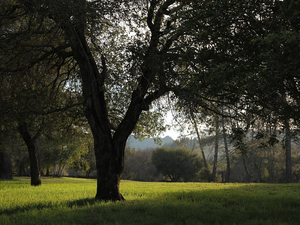Preserving oak woodlands protects the local ecology and contributes to the environment as a whole. The oak canopy fosters growth of inter-dependent species, plants and animals. The canopy shades the ground in the hot summers, and reduces temperatures and inhibits growth of grasses that accelerate wild fires. An intact ecosystem is home to many native species that collectively keep systems resilient.
Healthy woodlands filter water during the rainy season, reducing erosion and slowing down the runoff. They also channel more rainwater into the aquifer, the underground reservoirs that supply wells and leak slowly into springs to keep reservoirs full and creekside vegetation healthy in the dry season.
Clear-cutting watershed woodlands results in faster runoff in the rainy season, more floods, more erosion, decrease in biodiversity, more water consumption, and less available water for surrounding and downstream areas.
Woodlands also take carbon dioxide out of the atmosphere and sequester it in the form of wood. This is a huge climate service, particularly as we face challenges of how to arrest global warming.

